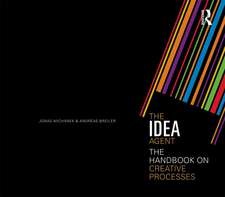Making It All Work: A Pocket Guide to Sustain Improvement And Anchor Change
Autor John Schultzen Limba Engleză Hardback – 30 iul 2010
Fundamental organizational performance techniques are introduced during each step to assist in managing the transformation from idea to integrated solution. These practices are not new or revolutionary, but often overlooked while team members focus on statistical and analytical means The described methods have a decidedly human focus and are meant to supplement the familiar diagnostic tools associated with six-sigma and process improvement projects.
| Toate formatele și edițiile | Preț | Express |
|---|---|---|
| Paperback (1) | 381.72 lei 6-8 săpt. | |
| Taylor & Francis – 30 iul 2010 | 381.72 lei 6-8 săpt. | |
| Hardback (1) | 1000.87 lei 6-8 săpt. | |
| Taylor & Francis – 30 iul 2010 | 1000.87 lei 6-8 săpt. |
Preț: 1000.87 lei
Preț vechi: 1220.57 lei
-18% Nou
Puncte Express: 1501
Preț estimativ în valută:
191.51€ • 199.97$ • 158.15£
191.51€ • 199.97$ • 158.15£
Carte tipărită la comandă
Livrare economică 15-29 aprilie
Preluare comenzi: 021 569.72.76
Specificații
ISBN-13: 9780415881029
ISBN-10: 0415881021
Pagini: 166
Ilustrații: 19 tables and Grant template but using Garamond
Dimensiuni: 152 x 229 x 11 mm
Greutate: 0.47 kg
Ediția:New.
Editura: Taylor & Francis
Colecția Routledge
Locul publicării:Oxford, United Kingdom
ISBN-10: 0415881021
Pagini: 166
Ilustrații: 19 tables and Grant template but using Garamond
Dimensiuni: 152 x 229 x 11 mm
Greutate: 0.47 kg
Ediția:New.
Editura: Taylor & Francis
Colecția Routledge
Locul publicării:Oxford, United Kingdom
Notă biografică
John Schultz has taught for over 20 years and was a program director administering an Advanced Technical Certificate program in Quality Management. In addition, he has 25 years experience as a consultant, technical services manager, and product development engineer. He is the author of magazine and journal articles on performance improvement and system change.
Cuprins
Introduction What this book is all about Why system improvements sometimes fail to achieve expectations System improvement includes problem identification and solution implementation Making things work A Practical Approach to Sustaining Improvement Lewin's three step model Applying Lewin's three steps Using teams to implement and sustain improvement Part One: Unfreezing A picture of spring Quotation The psychology behind creating the motivation to move on Frame the Need and Necessity for Making Improvement Recognizing the need for making improvement Why complacency is such a problem when making improvement Sources of Complacency Raising the level of awareness Framing the need and necessity for making improvements: How to make it happen An example of how it was done Create and Communicate a Unifying Purpose Why purpose is important Characteristics of an effective purpose Creating an effective purpose Communicating the purpose Communication also means setting the example Communicating up is also important Create and communicate a unifying purpose: How to make it happen An example of failing to create and communicate a purpose An example of a well communicated purpose Identify Formal and Informal Networks and Assure Their Participation What are formal and informal networks? Understanding and dealing with the organization's culture Creating new alliances Building trust Identify formal and informal networks and assure their participation: How to make it happen An example of why participation is important Create a Plan for Action Why plans are important Determining constraints that may become barriers to improvement Plans can be created in several different ways Establish timing Making the plan work Create a plan for action: How to make it happen An example of how to create a plan for action Part Two: Changing A picture of fall Quotation The psychology behind modifying attitudes and behaviors Create the Opportunity for Small but Meaningful Gains Why small gains are helpful The character of small gains and their relationship to the plan Time passes As work progresses Create the opportunity for small but meaningful gains: How to make it happen And example of why small gains work Empower People to Take Action What is empowerment? Barriers to empowerment Dealing with power and assuring the team's control Training makes it possible to operate in the new environment Putting people to work Empower people to take action: How to make it happen Examples illustrating why empowerment is important Manage Resistance to Improvement Reasons for resistance How people react to system Improvement Techniques for dealing with resistance to system improvement A mechanism for dealing with entrenched supervision Managing resistance to change: How to make it happen Examples contrasting the management of resistance to change Part Three: Refreezing A picture of winter Quotation The psychology behind stabilizing system modifications Complete the Restructuring of Daily Activities Keeping people on track and maintaining faithfulness to purpose Coordinating and integrating unfinished activities Creating new networks and relationships and eliminating the old ones Managing conflict to assure the completion of unfinished activities Making corrections and staying the course Complete the restructuring of daily activities: How to make it happen An example of where more coordination was needed Sustain Improvement Continue to measure and monitor process effectiveness Continue to monitor work group dynamics Documenting revised activities to maintain gains Wrapping up and bringing things to a close Sustain improvement: How to make it happen An example illustrating the importance of securing improvements Appendix Key Terms References Index
Descriere
This book demonstrates how to organize and manage change, so that improvements become the new way of life. Fundamental organizational performance techniques are introduced, and the book has a decidedly human focus that supplements the familiar diagnostic tools associated with six-sigma and process improvement projects.























